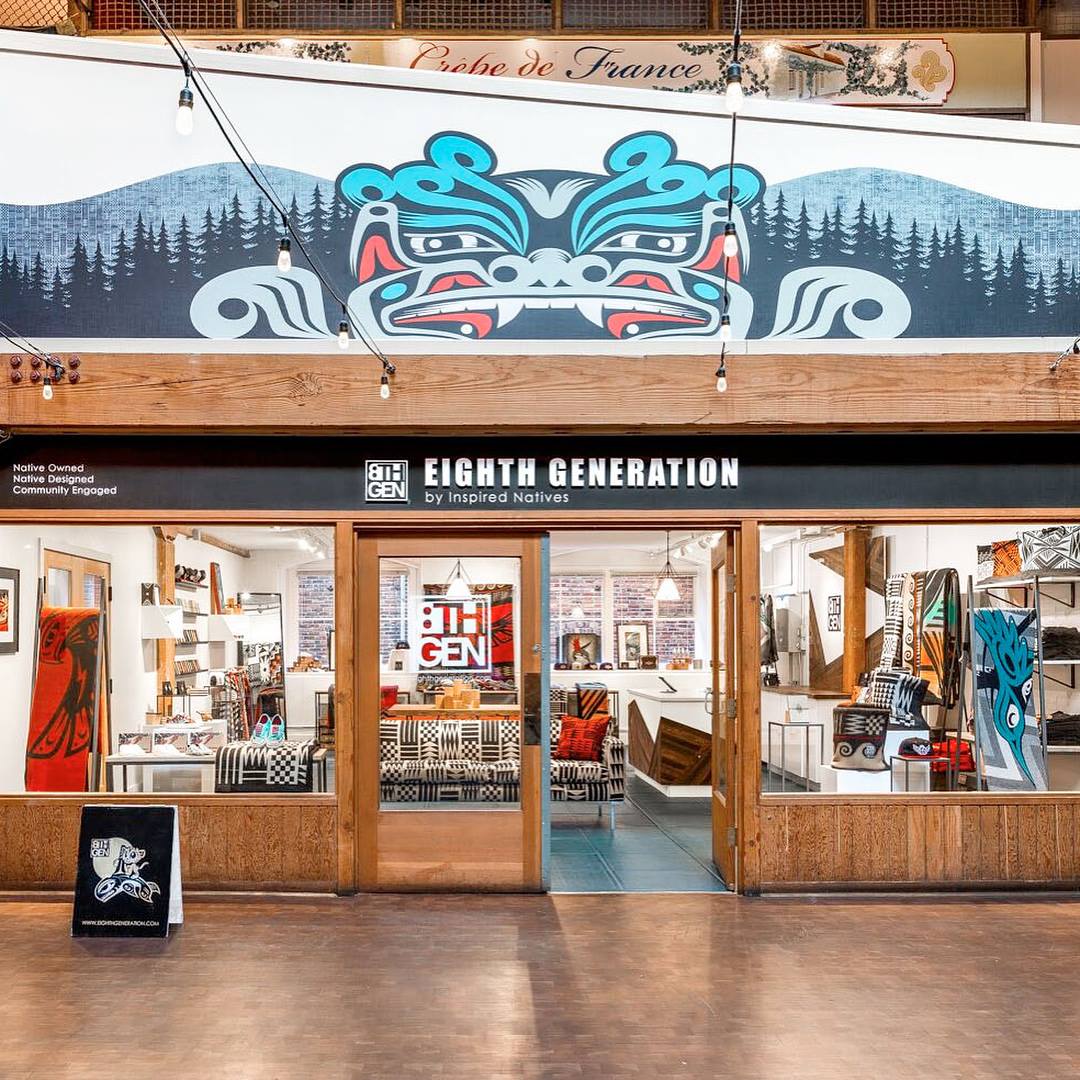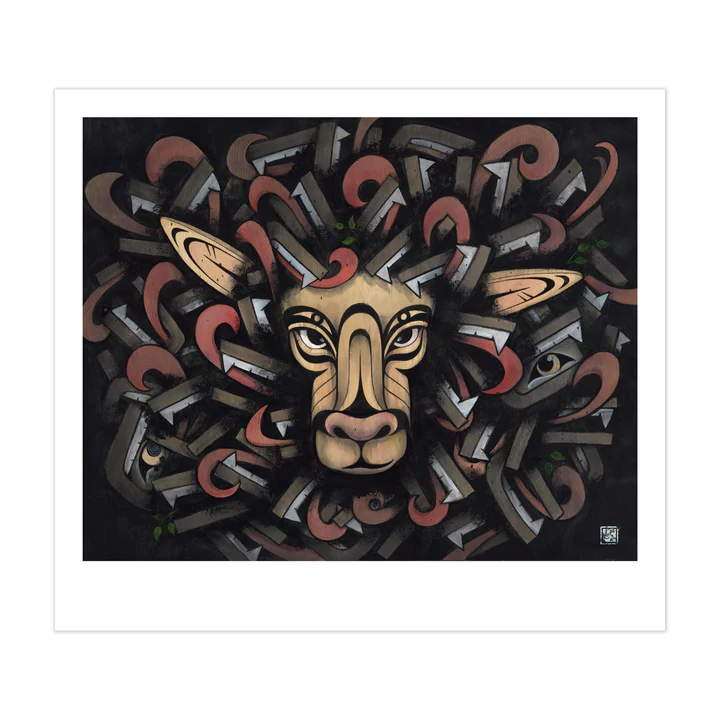Native Empowerment: An interview with Colleen Echohawk (part two)

The Eighth Generation flagship store at Pike Place Market
AG: How involved are you with the UW community? Do you ever talk with the First Nations RSO?
CE: Absolutely. I’ve supported First Nations forever. When I worked at UW in public health, we brought back the Elders’ Dinner at the Powwow. I am passionate about bringing traditional foods back. I grew up with traditional foods, so I loved the Elders’ Dinner. I am always excited to support First Nations.
AG: The work you do is about uplifting the Native community, and lifting up ourselves first before we can support others. To me, it makes sense for BIPOC to prioritize their own well-being. Do you have thoughts on that, especially since you’ve worked so much with the unhoused community?
CE: That’s a great question. When I worked at Youth Care it was a bit jarring because I’ve been so used to working with just Native people. But what occurred to me is that the skills I learned as an executive leader translate really well. I believe that 8th Generation should be mentoring and developing the next leaders in business. And I mean in business overall, not just in Indian country. I think we should be the leaders at Target and Costco and all over. There’s been a push down of Native thoughts, ideas and ways of being in this world, knowledge systems that haven’t been heard because of white supremacy. We haven’t seen BIPOC leadership in high levels of business and we haven’t seen women. Two years ago the Seattle Times had this profile of the top 10 highest paid business leaders in Washington State. Nine out of 10 were men. That’s insane. We have work to do to make sure that women are prioritized in business leadership moving forward. I love the opportunity to talk about this because we know in Native communities that our leaders are special, and that they have a different way of seeing the world.
When I was running for mayor, there were two things I knew I’d do if elected. The first thing I would do is have the tribes who have a government relationship with the city of Seattle come in and cleanse the space, like having the medicine people come into city hall. The second thing would be to establish an Elders Council. I believe in listening and hearing to our elders. Those are two examples of how as a Native woman leader I would lead in a different way than a non-Native man.
AG: You have a long history of working for nonprofits and on boards. How did you make the switch to an art and lifestyle company?
CE: I believe art is going to save us. I really believe that. I always worked hard to incorporate our traditional Native art in anything I was involved in. Because it’s part of our storytelling. It’s history. It’s all of those things. When we were designing al?al? (Chief Seattle Club’s first housing project) we prioritized bringing Native art into the building. The al?al? building now has one of the largest modern Native art collection anywhere in Seattle. There’s over 65 pieces of art in there. This art is meaningful to me and I believe in it.
AG: How did 8th Generation get its start?
CH: We were founded by Louie Gong, a Nooksack artist. Louie and I have been friends for a long time, Louie started making cultural art on shoes. He was drawing Native designs with sharpies on Vans. And he realized people are hungry for this kind of art. Art that is Native. Art that is on everyday products.

Black Sheep by Louie Gong
There was also this strong history of Pendleton in the Native community. I’ve been given almost 20 Pendletons. Like many Native people they were given to me for special occasions and ceremony. But the reality is Pendleton took a lot of our cultural art. They co-opted it and turned it into whatever they thought was good for the market, making millions of dollars. In the Native community, we buy their products because it’s the only place we see Native art represented in home goods. Because of Eighth Generation, my kids open a cupboard and they see a beautiful 8th Generation mug, designed by a Native artist. We had nothing like that growing up. We only had Pendleton and some cultural art that was handmade. Louie saw the need and hunger for authentic Native art and started 8th Generation. He forged connections to other artists and created an amazing company. We are now owned by the Snoqualmie Tribe and I feel so fortunate to work for one of the local Tribes.
I believe this company has the ability to change so many things. We should be building prosperity in the Native community. I loved hearing that you were focusing on accounting because we need Native accountants, we need Native CFOs, we need Native COOs. The next business leaders in this country should be Native. We will bring our own way of understanding capitalism and what shared prosperity means. That is the way we will change the racial wealth gap. We cannot trust the white saviors of this world to do it for us. We’ve tried that. It hasn’t worked. I appreciate our white allies, community members, advocates, and supporters, but the best things they can do is invest in Indigenous owned businesses. Get out of the way but be willing to help make the connections. I see 8th Generation as an extension of my work supporting Native folks who are experiencing homelessness. They’ve had the worst of everything in this country. If I can be doing the work upstream to support Native families, so that a broken leg or losing a job does not immediately throw them into homelessness, then we are doing something right. That’s how I decided this was going to be the next step for me. My work is 100% still focused on the uplifting and prosperity of Native people and community.
AG: What’s made this role the best job you’ve had?
CE: I loved the work I did in homelessness and housing. It was so wonderful. But it was also heavy. The folks that we served, they were not just numbers to me. They were real people, sometimes they were family members. It’s hard. After I left, I realized, “Wow, it feels nice to not have that heaviness on me.” The other thing I love about this company is that it’s such a creative place. I’ve never worked in a place where I can dive into my creativity. I’m not an established artist, but I definitely have ideas about design. I get to guide the narrative of where we want to go as a company. This is one of the most talented teams I’ve ever worked with. It’s fun to throw out an idea and hear, “Yeah, we should do that!” And then we continue to bounce ideas off each other. It’s really special.
AG: As you settle into your role as CEO for 8th Generation, what do you foresee being challenging?
CE: The most challenging thing is going to be helping the non-Native community know that they are welcome to buy Native art and design. In the five months I’ve been here, I’ve realized this is a big problem. There’s only so many Native people in this country and so many Indigenous people in the world. If we look in people’s homes right now, we see the impact of the colonists’ world on what we buy every day at Target, at Costco, at TJ Maxx. That’s where I shop [Laugh]. I can afford things in TJ Maxx, but I see nothing there that represents me and my culture. Nor do I see things that represent the historic communities of our country. To me, that’s racism.
Now we have this opportunity for the non-Native community to be an ethical buyer and to know that not one piece of artwork here at 8th Generation comes from a ceremonial place. It’s just our designs. It’s just what should be commonplace in this world. We had Sarah Agaton Howes, an Anishinaabe artist who designs for Eighth Generation, visit yesterday. She went on our Instagram live to answer the question people ask us every day, “I’m non-Native, can I buy these products?” Sarah said it beautifully, “As a traditional Anishinaabe woman, I would never sell my ceremonial design, ceremonial art, story, or songs. Everything that I have here in 8th Generation is to bring joy and beauty to people’s homes.” If we’re going to take this company global, we have to get that message across.
AG: Do you have plans on how to get this message out?
CE: Yes. We just did a Tik Tok that reached over 1.1 million views about cultural appropriation. The video asks the question, as a non-Native person can I buy Native art or not? We get that question every day. We have opportunity to educate people and we’re trying to do it in ways that are also entertaining.
We added a tagline that says “Native designed for all.” We need to message directly to the non-Native audience that this is Native designed for you, our customer. We want you to buy this product and support the vitality of the Native community. That is part of what our email marketing strategies, our storytelling, our educational work is focused on. The other challenge is getting products out there. We need to be in Nordstrom, we need to be in Costco, and of course, TJ Max.
@eighthgeneration appreciation not appropriation 😌 #nativetiktok #nativeownedbusiness #nativemade #supportartists #inspirednatives #eighthgeneration
♬ We Dont Talk About Bruno But Theres A Platypus – David T. Simon
AG: Working at 8th Generation seems like a continuation of your people-driven career. And going into the creative field is exciting.
CE: I’m so thrilled to be in this space. We have some folks who’ve worked on homelessness in the city for 20 to 30 years, and it’s hard. I didn’t realize how hard it was until after I got out. We need to care for those people and understand they’re going through their own trauma. In the Native community, it was even harder, because we literally worked with people that are our families.
How’s your family doing now?
AG: My mom is living on the Suquamish reservation with my younger brother. We’re going through a recession, so she’s trying to prepare and make sure she can get through that. I’m doing okay, living in the city with financial aid for my last year of school. I have a job lined up after graduating. My cousins are in Poulsbo. The oldest is a Division 1 swimmer at the University of Utah. We’re doing well as a whole, but we’re also keeping an eye on this recession and inflation.
CE: I’m thinking about that every day. It is a challenge for 8th Generation; the economy, the pandemic, the war in Ukraine. I’m thinking about all of these global factors. It can be tough to strategize with a company so young and with such high ambitions. It’s going to be a careful balancing act for a couple of years. But I’ve done balancing acts before, so I feel prepared!
Read a profile of Annicette Gilliam and learn more about the 2023 First Nations Spring Powwow in Foster Business Magazine.
